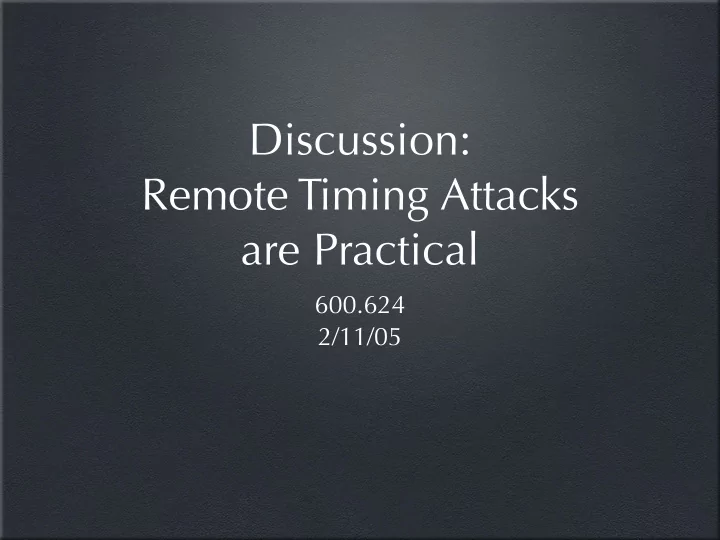

Discussion: Remote Timing Attacks are Practical 600.624 2/11/05
Outline • Why are timing attacks important? • Clarifications • Zero-One Gap / Neighborhood Size etc. • Problems • Questions • Extensions • Contribution • Discussion
How fast can we factor? • Seny: RSAP. How do you go after crypto? • RSA Challenge • RSA-576 • 576 bits (174 digits) • Factored in 2 years (2001-2003) used “Lattice Sieving” • http://www.rsasecurity.com/rsalabs/
How fast can we factor? (2) • Number Field Sieves • “Fast Algorithms” • Complexity: O ( e c (log n ) 1 / 3 (log log n ) 2 / 3 )
Dangers of Timing Attacks • Probably not going to crack RSA (or El Gamal) any time soon • Dangers: Poor passwords (keys, entropy), timing attacks
Clarifications
What is the Zero-One Gap? Zero-One Gap = | � 1 - � 0 | � 1 � 0 time guess of q
Zero-One Gap
What is the “neighborhood size”? • Need to get better estimates at number of reductions (more on that later...) n � T g = DecryptTime ( g + i ) 1=0 n � T g hi = DecryptTime ( g hi + i ) 1=0 ∆ = | T g − T g hi | • Why increment i ? (Multiplication??)
Neighborhood
Neighborhood
1 ms? • State that 1 ms of Zero-One Gap is sufficient for attack. • Where did this number come from?
1 ms (2) Can we really tolerate 1 ms network variance?
Problems
Great Paper! (?) • Were the mathematics adequately explained? • Did they provide empirical evidence that this attack is feasible?
“remote timing attacks are PRACTICAL “ • Setup: • 3 Hop Network • Load on the server • Experiments: • broke 2.5/3 keys • sample size (?!?) • What does this mean for failure rate?
Questions • What about the first bits?
Questions (2) • Would using OAEP prevent the attack? • Quick Answer: no. • What about RSA Signatures? • hashing?
Questions (3) • Why include the VM Model? • Some people liked it... • What is the failure rate? • Come back to this...
Questions (4) • How are they averaging their timing samples? • What does this imply about distribution? • What does this mean about their error rate?
Defenses (”Hacks”) • Queueing Algorithms • Add a delay on decryption failure • Application layer Firewall • What about RSA batching?
Better Defenses (?) • Blinding • “Are we wrong to rely on blinding considering it isn’t provably secure?” • Quantizing
Extensions • What is the smallest neighborhood/sample size parameters such that the attack will work?
Extensions (2) • Are there p/q or e/d pairs for which Multiplication and Reductions offset? (See key 3.) If so, what percent of the key space is vulnerable? (HARD??)
Contribution • We all accepted this paper... discuss why.
Discussion • Anything you would like to bring up?
Recommend
More recommend